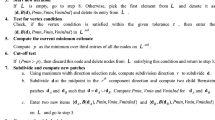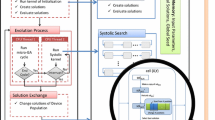Abstract
A graphics processing unit (GPU) has been widely used to accelerate discrete optimization problems. In this paper, we introduce a novel hybrid parallel algorithm to generate a shortest addition chain for a positive integer e. The main idea of the proposed algorithm is to divide the search tree into a sequence of three subtrees: top, middle, and bottom. The top subtree works using a branch and bound depth first strategy. The middle subtree works using a branch and bound breadth first strategy, while the bottom subtree works using a parallel (GPU) branch and bound depth first strategy. Our experimental results show that, compared to the fastest sequential algorithm for generating a shortest addition chain, we improve the generation by about 70% using one GPU (NVIDIA GeForce GTX 770). For generating all shortest addition chains, the percentage of the improvement is about 50%.

Similar content being viewed by others
References
Campeotto, F., Dovier, A., Fioretto, F., Pontelli. E.: A GPU implementation of large neighborhood search for solving constraint optimization problems. In: Proceedings of the European Conference on Artificial Intelligence (ECAI). pp. 189–194 (2014)
Hawick, K., Leist, A., Playne, D.: Parallel graph component labelling with gpus and cuda. Parallel Comput. 36(12), 655–678 (2010)
Harish, P., Narayanan, P.J.: Accelerating large graph algorithms on the GPU using CUDA. In: Aluru, S., Parashar, M., Badrinath, R., Prasanna, V.K. (eds.) High Performance Computing-HIPC. Lecture Notes in Computer Science, pp. 197–208. Springer, New York (2007)
Chen, C., Schmidt, B., Weiguo, L., Muller-Wittig, W.: GPU-MEME: Using graphics hardware to accelerate motif finding in DNA sequences. Pattern Recognition in Bioinformatics, Third IAPR International Conference, PRIB, Melbourne. Lecture Notes in Computer Science, Springer. pp. 52–65 (2008)
Zhou, Y., Xu, W., Donald, B.R., Zeng, J.: An efficient parallel algorithm for accelerating computational protein design. Bioinformatics 30(12), 255–263 (2014)
Biryukov, A., Großschädl, J.: Cryptanalysis of the full AES using GPU-like special-purpose hardware. Fundam. Inform. 114, 221–237 (2012)
Pan, W., Zheng, F., Zhao, Y., Zhu, W.T., Jing, J.: An efficient elliptic curve cryptography signature server with GPU acceleration. IEEE Trans. Inform. Forensics Secur. 12(1), 111–122 (2017)
Milob, F., Bernaschia, M., Bissonb, M.: A fast, GPU based, dictionary attack to openPGP secret keyrings. J. Syst. Softw. 84, 2088–2096 (2011)
Diffie, W., Hellman, M.E.: New directions in cryptography. IEEE Trans. Inform. Theory 22(6), 644–654 (1976)
ElGamal, T.: A public-key cryptosystem and a signature scheme based on discrete logarithms. IEEE Trans. Inform. Theory 31, 469–472 (1985)
Rivest, R., Shamir, A., Adleman, L.: A method for obtaining digital signatures and public-key cryptosystems. Commun. ACM. 21(2), 120–126 (1978)
Takagi, T.: Fast RSA-type cryptosystem modulo \(p^k q.\) In: Advances in Cryptology—CRYPTO'98, 18th Annual International Cryptology Conference, Santa Barbara, California, USA, August 23-27, 1998. Lecture Notes in Computer Science, vol. 1462, pp. 318–326 (1998)
Brickell, E.F., Gordon, D.M., McCurley, K.S., Wilson, D.B.: Fast exponentiation with precomputation. In: Rueppel, R.A. (ed.) Advances in Cryptology—EUROCRYPT’92, Workshop on the Theory and Application of Cryptographic Techniques, Balatonfured, Hungary, May 24-28, 1992. Lecture Notes in Computer Science, vol. 658, pp. 200–207. Springer, New York (1992)
Bos, J., Coster, M.: Addition chain heuristics. In: Brassard, G. (ed.) Advances in Cryptology—CRYPTO’89, 9th Annual International Cryptology Conference, Santa Barbara, California, USA, August 20-24, 1989. Lecture Notes in Computer Science, vol. 435, pp. 400–407. Springer, New York (1989)
De Rooij, P.: Efficient exponentiation using precomputation and vector addition chains. In: Helleseth, T. (ed.) Advances in Cryptology—EUROCRYPT’94, Workshop on the Theory and Application of Cryptographic Techniques, Perugia, Italy, May 9-12, 1994. Lecture Notes in Computer Science, vol. 950, pp. 389–399. Springer, New York (1994)
Gordon, D.M.: A survey of fast exponentiation methods. J. Algorithms 122, 129–146 (1998)
Fathy, K., Bahig, H., Ragab, A.: A fast parallel modular exponentiation algorithm. Arab. J. Sci. Eng. 43, 903–911 (2018)
Bahig, H.: A fast optimal parallel algorithm for a short addition chain. J. Supercomput. 74(1), 324–333 (2018)
Downey, P., Leong, B., Sethi, R.: Computing sequences with addition chains. SIAM J. Comput. 10(3), 638–646 (1981)
Bahig, H., Bahig, H.: A new strategy for generating shortest addition sequences. Computing 91, 285–306 (2011)
Knuth, D.E.: Art of Computer Programming, Volume 2: Seminumerical Algorithm, pp. 461–485. Addison-Wesley, Reading (1997)
Bleichenbacher, D., Flammenkamp, A.: An efficient algorithm for computing shortest addition chains. http://www.homes.uni-bielefeld.de/achim/additionchain.html (unpublished)
Chin, Y.H., Tsai, Y.H.: Algorithms for finding the shortest addition chain. In: Proceedings of national computer symposium, Kaoshiung, Taiwan. December 20–22, pp. 1398–1414 (1985)
Thurber, E.G.: Efficient generation of minimal length addition chains. SIAM J. Comput. 28, 1247–1263 (1999)
Bahig, H.: Improved generation of minimal addition chains. Computing 78, 161–172 (2006)
Bahig, H.: Star reduction among minimal length addition chains. Computing 91, 335–352 (2011)
Clift, N.M.: Calculating optimal addition chains. Computing 91(3), 265–284 (2011)
Schnhage, A.: A lower bound for the length of addition chains. Theor. Comput. Sci. 1, 1–12 (1975)
Thurber, E.G.: The Scholz–Brauer problem on addition chains. Pac. J. Math. 49, 229–242 (1973)
NVIDIA. NVIDIA CUDA C Programming Guide, CUDA Toolkit Documentation
Mahafzah, B., Mohammad, A.: The optical chained-cubic tree interconnection network: topological structure and properties. Comput. Electr. Eng. 38(2), 330–345 (2012)
Mahafzah, B., Sleit, A.: The OTIS hyper hexa-cell optoelectronic architecture. Computing 94(5), 411–432 (2012)
Mahafzah, B.: Performance evaluation of parallel multithreaded A* heuristic search algorithm. J. Inform. Sci 40(3), 363–375 (2014)
Mahafzah, B.: Parallel multithreaded IDA* heuristic search: algorithm design and performance evaluation. Int. J. Parallel Emerg. Distrib Syst. 26(1), 61–82 (2011)
Author information
Authors and Affiliations
Corresponding author
Rights and permissions
About this article
Cite this article
Bahig, H.M., AbdElbari, K.A. A fast GPU-based hybrid algorithm for addition chains. Cluster Comput 21, 2001–2011 (2018). https://doi.org/10.1007/s10586-018-2840-5
Received:
Revised:
Accepted:
Published:
Issue Date:
DOI: https://doi.org/10.1007/s10586-018-2840-5




